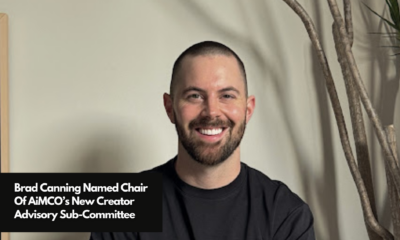Talent Collectives
Creator-First Approach Makes All The Difference For Trend’s Growth
Ted Raad’s wife Dede once turned down a brand deal worth more than his monthly corporate salary. When asked why, she replied that people were following her on social media because of her advice, not because they saw her on TV. She did not want to betray that trust.
This disconnect revealed a common problem in influencer management: Agencies were pushing creators toward high-paying deals regardless of fit, while creators like Dede wanted to maintain audience trust through genuine partnerships. When Dede and her management company parted ways, Ted, who was working as a manager at HP at the time, stepped in to help—first managing her and three friends, then expanding as word spread about their creator-first approach.
This was the birth of Trend, a Houston-based venture launched in 2019 that now manages 140 creators and counting across fashion, lifestyle, family, beauty, fitness, and entertainment niches who seek honest representation.
“If you’re a management company, the focus should always be on the creator,” emphasizes Ted. “It’s not just about deals. It’s about making sure that creators have somebody on their side to be the best they could for their audience.”
The Trend Difference: Inside Their Creator-First Approach
Trend’s value proposition centers on three core principles that distinguish it in the creator management field: exceptional personal attention, genuine brand alignment, and transparent business practices.
“Our ratios are the lowest in the industry between a manager and a creator. Five to one is our ratio, but most of our managers only manage three,” Ted explains, contrasting with industry averages of 10-20 creators per manager.
New managers at Trend spend months observing and learning before taking on their own roster of creators.
This high-touch approach enables Trend to develop a deep understanding of each creator’s audience, content style, and long-term goals. “That uniqueness in knowing each individual creator and what they’re trying to accomplish really sets us apart,” Ted notes.
According to him, this investment in personal attention has practical benefits: Managers can better assess which brand partnerships will truly match a creator’s audience.
The second pillar of Trend’s approach is keeping a clear separation between creator management and brand services.
“What I didn’t want to happen was that a manager who’s advocating for creators is also advocating for brands. I don’t think that works well,” Ted explains. “Your manager is advocating just for you. They could care less about what the brand wants in general other than their long-term relationship with you.”
Finally, Trend encourages direct creator-brand relationships. “We don’t even gatekeep the contacts. We put the contacts in our project manager tool. They see it and we want them to get to know them,” Ted reveals. “Let us handle the nitty-gritty and the dirty stuff. But the fun stuff, please, go hang out, have dinner, and do something.”
The Trend Companies Ecosystem
As Trend’s client base expanded beyond fashion and lifestyle creators, Ted saw opportunities to provide more comprehensive support through specialized divisions.
“Over time, brands would knock on our door and say, ‘Hey, we need help with our overall strategy,'” Ted explains.
This led to the creation of Trend Social, which develops influencer marketing strategies for brands. This division uses Trend’s creator insights to help brands build effective campaigns without compromising the independence of creator management.
Similarly, Trend Elevate emerged to help creators diversify revenue streams beyond brand partnerships. “We develop the strategy for the creator and say, ‘Hey look, you’re wearing this every day. You have a good opportunity to link it and get extra commission off it,'” Ted explains. This division focuses on affiliate marketing, commission strategies, and other monetization opportunities that align with creators’ authentic content.
The company also expanded into Trend Athletes after Ted connected with athletes facing similar representation challenges. “I’ve somehow become friends with a few athletes who were like, ‘Hey, I don’t feel like I’m getting advocated at all in my space,'” he notes.
Each expansion maintains Trend’s core principle of advocacy: “Every kind of business that we’ve tapped into has come to how we can help our creators with that long-term strategy, get to where they want to get to, and feel like someone’s a partner with them.”
What Success Looks Like for Trend
For Ted, success isn’t measured by deal volume or dollar value but by how well Trend serves creators’ individual goals—a divergence from industry norms focused on maximizing revenue.
“We manage a lot of moms and a lot of dads, and there’s a lot of things that are taxing on their life,” Ted explains. “Many of them just want to be there for their family and just take a few campaigns per year. And we tell them, if that’s your goal, we want to help you with that goal, not just how much money you can make in a year.”
This personalized approach also applies to their regular creator reviews. “We have end-of-year reviews and mid-year reviews, and we always say they’re not for you; they’re for us,” Ted says. “They’re for us to tell you this is how we understood your strategy and executed it.”
Ted believes this perspective has proven especially valuable for female creators. “This is the first time, I believe in history, where the glass ceiling is broken on what the earning potential can be for women,” he observes. “A lot of people dog on social media, but look at the opportunities it’s providing to people that never could be provided before.”
The results of this approach show in their work with brands like Steve Madden, where a commission-only partnership with five influencers outperformed celebrity endorsements.
“The five of them combined sold way more than the five previous celebrities they had on their launch,” Ted recalls. “These influencers have garnered relationships with their audience. Their audience feels like the person they’re talking to is the person next door.”
Market Challenges
Despite the growth of the creator economy, Ted acknowledges current challenges, particularly with economic uncertainty affecting brand spending.
“Talking to brands, we found that they’re much more reserved and all of a sudden caring a lot about what those sales look like after those partnerships,” Ted observes.
His advice to creators during tighter economic periods: “Be okay with adjusting and being flexible with your rates and with brands. If brands get a little bit more tight on their budgets, while still being true to who you are, do not be afraid to take a little bit lower rate than normal.”
This flexibility, Ted argues, maintains relationships that will prove valuable when economic conditions improve: “The brands, in response, if 2026 turns around as a good year, will come back to that person immediately.”
As brands increasingly rely on metrics for their influencer investments, Trend’s emphasis on measurable results has been important. “Link clicks will typically show a direct correlation between the number of clicks and the actual checkout conversion,” Ted explains. “That seems to be the one that we see is very attractive to brands.”
Keys to Creator Success
From his position overseeing thousands of campaigns annually, Ted identifies two key elements for creator success: retention and growth.
“Top-performing creators do a very good job of retention with their audience,” he explains. “You have to keep your audience engaged, whether through storytelling on your stories or through explaining what you provide as a value to your audience.”
Different platforms require, he continues, different approaches. “The same posts on Instagram Reels and TikTok don’t typically work the same,” Ted notes. “TikTok, you’ve got to be more yourself. You’ve got to be more out there. Instagram Reels is more creative. You got to get to the point.”
For up-and-coming creators, his advice is straightforward: “Be who you are. Post consistently and be persistent. It’s not going to happen overnight.”
He points to successful creators who took years to find their breakthrough: “We’ve signed creators this year that have been doing it since 2017. And then all of a sudden, this year, they found a spike. The algorithm changed, and it worked in their favor.”
Relationship Building in Creator Management
As Trend continues to grow, Ted remains committed to quality over scale. “Speed at the detriment of quality is not worth it,” he emphasizes. “If my goal is to make sure that every creator has the right representation they need for what they’re trying to achieve, then that’s how we’re going to get there.”
It’s no different when it comes to their hiring practices. “We hire people who sit around for two or three months and just watch and learn and help people with their stuff before they even take on a creator,” Ted explains. “They need to know the Trend values and why we exist in order to get there.”
While fostering quality might potentially mean slower growth, Ted believes that it ensures that each creator receives the full benefit of Trend’s advocacy approach—contributing to a more stable creator economy where genuine connections and audience trust remain essential.
“Creators are providing value that has not been provided in the past. They provide a unique look into people’s lives,” Ted reflects. “It’s a scary space. And we just hope we can help creators feel like it’s a less scary space with us next to them.”





















